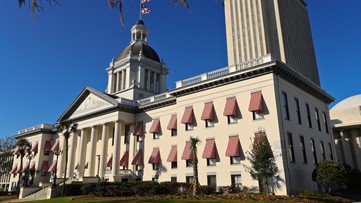St. Petersburg installs $700K flood barrier to protect critical wastewater facility – wtsp.com

Report on Infrastructure Resilience and Sustainable Development in St. Petersburg
Introduction: Proactive Measures to Safeguard Critical Urban Services
The city of St. Petersburg, Florida, has implemented a significant infrastructure protection measure to enhance its resilience against climate-related flood risks. A 500-foot AquaFence has been installed around the critical lift station 85, located at the former Albert Whitted Water Reclamation Facility. This initiative is a direct response to the increasing threat of extreme weather events and is fundamental to achieving key Sustainable Development Goals (SDGs) related to infrastructure, water sanitation, and climate action.
Project Details and Operational Context
Lift station 85 is a vital node in the city’s sanitation network, managing wastewater flows for 25 percent of the city, including the entire downtown area and all local hospitals. The station screens wastewater for solids before six pumps transfer the flow to the Southwest Water Reclamation facility for full treatment. A previous disruption during Hurricane Helene, which caused flooding at the Southwest facility, necessitated a shutdown of lift station 85, highlighting its vulnerability. The newly installed 9-foot-tall AquaFence barrier is designed to prevent a recurrence of such a shutdown, ensuring operational continuity during severe weather.
Alignment with United Nations Sustainable Development Goals (SDGs)
The project demonstrates a strong commitment to the 2030 Agenda for Sustainable Development, directly contributing to several SDGs:
- SDG 6: Clean Water and Sanitation: By protecting essential wastewater infrastructure, the city ensures the uninterrupted operation of sanitation services. This prevents the potential for untreated sewage release during floods, thereby safeguarding public health and protecting local water ecosystems from pollution, directly supporting Target 6.3 on improving water quality.
- SDG 9: Industry, Innovation, and Infrastructure: The deployment of the AquaFence is an investment in building resilient infrastructure (Target 9.1). It represents the adoption of innovative technology to upgrade and protect a critical facility, enhancing its capacity to withstand climate shocks and ensuring its long-term reliability.
- SDG 11: Sustainable Cities and Communities: This initiative is a core component of making St. Petersburg a safer, more resilient, and sustainable city. By safeguarding critical urban services from climate-related disasters, the city significantly reduces the risk of service disruption and economic loss, directly addressing Target 11.5.
- SDG 13: Climate Action: The installation is a tangible climate adaptation measure. It strengthens the city’s resilience and adaptive capacity to climate-related hazards and natural disasters (Target 13.1), demonstrating a proactive approach to managing the impacts of climate change.
Financial Investment and Justification
The AquaFence project was financed with $700,000 from the city’s water and sewer revenue. Public Works officials have framed this expenditure as a strategic investment, akin to an insurance policy. This investment protects a multi-million dollar asset and the essential public service it provides, representing a fiscally responsible approach to climate adaptation and sustainable asset management.
Comprehensive Resilience Strategy and Future Outlook
The AquaFence is part of a broader, multi-layered strategy to storm-proof key facilities. The city is implementing several complementary measures to enhance the resilience of lift station 85, including:
- Elevating critical components inside the facility.
- Implementing secondary measures and redundancies.
- Installing flood barriers on doors.
- Applying waterproof coatings to structures.
This comprehensive approach underscores the city’s ongoing commitment to identifying and protecting vulnerable infrastructure. St. Petersburg continues to assess its facilities to determine the most effective methods for preventing flood damage, ensuring that progress toward a sustainable and resilient urban environment is systematic and continuous.
Analysis of Sustainable Development Goals (SDGs) in the Article
1. Which SDGs are addressed or connected to the issues highlighted in the article?
-
SDG 6: Clean Water and Sanitation
The article focuses on protecting a critical wastewater lift station. This infrastructure is essential for managing sewage for “25 percent of the city,” ensuring that wastewater is properly handled and treated, which is a core component of SDG 6.
-
SDG 9: Industry, Innovation, and Infrastructure
The installation of the AquaFence is a direct investment in making critical infrastructure resilient. The article highlights the importance of lift station 85 as a “critical infrastructure” and the project’s goal to “storm proof key services,” aligning with the goal of developing reliable and resilient infrastructure.
-
SDG 11: Sustainable Cities and Communities
The project is a municipal effort by the city of St. Petersburg to protect its urban services and population from disasters. By safeguarding the wastewater system from flooding, the city is making itself more resilient and sustainable, directly contributing to the aims of SDG 11.
-
SDG 13: Climate Action
The protective measures are a response to the threat of flooding from hurricanes, which are climate-related hazards. The article mentions that “Hurricane Helene caused significant flooding” previously, and the new infrastructure is an adaptation measure to strengthen resilience against such future events.
2. What specific targets under those SDGs can be identified based on the article’s content?
-
Target 6.3: By 2030, improve water quality by reducing pollution… halving the proportion of untreated wastewater.
The article explains that the lift station handles “all of the sewage for the downtown area.” Protecting it from flooding prevents a shutdown, which would otherwise lead to the potential release of untreated wastewater, thereby supporting this target.
-
Target 9.1: Develop quality, reliable, sustainable and resilient infrastructure… to support economic development and human well-being.
The city’s project to install a “$700,000” AquaFence and implement other measures like “elevating critical components” is a clear example of developing resilient infrastructure to ensure the reliable, 24/7 operation of a service essential for human well-being, as it serves “all of the hospitals.”
-
Target 11.5: By 2030, significantly reduce… the direct economic losses… caused by disasters, including water-related disasters, with a focus on protecting… people in vulnerable situations.
The investment is described as “insurance to protect a facility that is millions and millions of dollars,” directly addressing the goal of reducing economic losses from disasters like hurricane-induced floods. It protects a key service for a quarter of the city’s population.
-
Target 13.1: Strengthen resilience and adaptive capacity to climate-related hazards and natural disasters in all countries.
The entire project is an exercise in strengthening resilience. The city is actively “doing everything it can to storm proof key services” and “looking at vulnerable infrastructure to determine the best way to prevent flooding,” which is a direct implementation of climate adaptation strategies.
3. Are there any indicators mentioned or implied in the article that can be used to measure progress towards the identified targets?
- Financial Investment in Resilience: The article explicitly states the cost of the AquaFence is “$700,000,” which serves as a direct financial indicator of investment in resilient infrastructure and disaster risk reduction (Targets 9.1, 11.5).
- Physical Implementation of Protective Measures: Specific physical metrics are provided, such as “500 feet of AquaFence” and a “9-foot-tall barrier.” Other measures mentioned include “elevating critical components,” “flood barriers on the door,” and “waterproof coatings,” which are all tangible indicators of progress in building resilience (Targets 9.1, 13.1).
- Scope of Service Protection: The article notes that the facility serves “25 percent of the city” and “all of the hospitals.” This quantifies the population and critical services being protected, serving as an indicator for the impact of the resilience measures (Targets 6.3, 9.1, 11.5).
- Value of Protected Assets: The statement that the fence protects a facility worth “millions and millions of dollars” is an indicator of the economic assets being safeguarded from disaster-related losses (Target 11.5).
- Continuity of Operations: The primary goal is to “keep wastewater flowing” and ensure the “24/7 operation” of the lift station. The successful, uninterrupted operation of this facility during a future flood event would be the ultimate indicator of the project’s success (Targets 6.3, 9.1).
4. Table of SDGs, Targets, and Indicators
| SDGs | Targets | Indicators |
|---|---|---|
| SDG 6: Clean Water and Sanitation | 6.3: Improve water quality and reduce the proportion of untreated wastewater. |
|
| SDG 9: Industry, Innovation, and Infrastructure | 9.1: Develop quality, reliable, sustainable and resilient infrastructure. |
|
| SDG 11: Sustainable Cities and Communities | 11.5: Reduce economic losses and people affected by disasters. |
|
| SDG 13: Climate Action | 13.1: Strengthen resilience and adaptive capacity to climate-related hazards. |
|
Source: wtsp.com

What is Your Reaction?
 Like
0
Like
0
 Dislike
0
Dislike
0
 Love
0
Love
0
 Funny
0
Funny
0
 Angry
0
Angry
0
 Sad
0
Sad
0
 Wow
0
Wow
0
























;Resize=805#)






















































